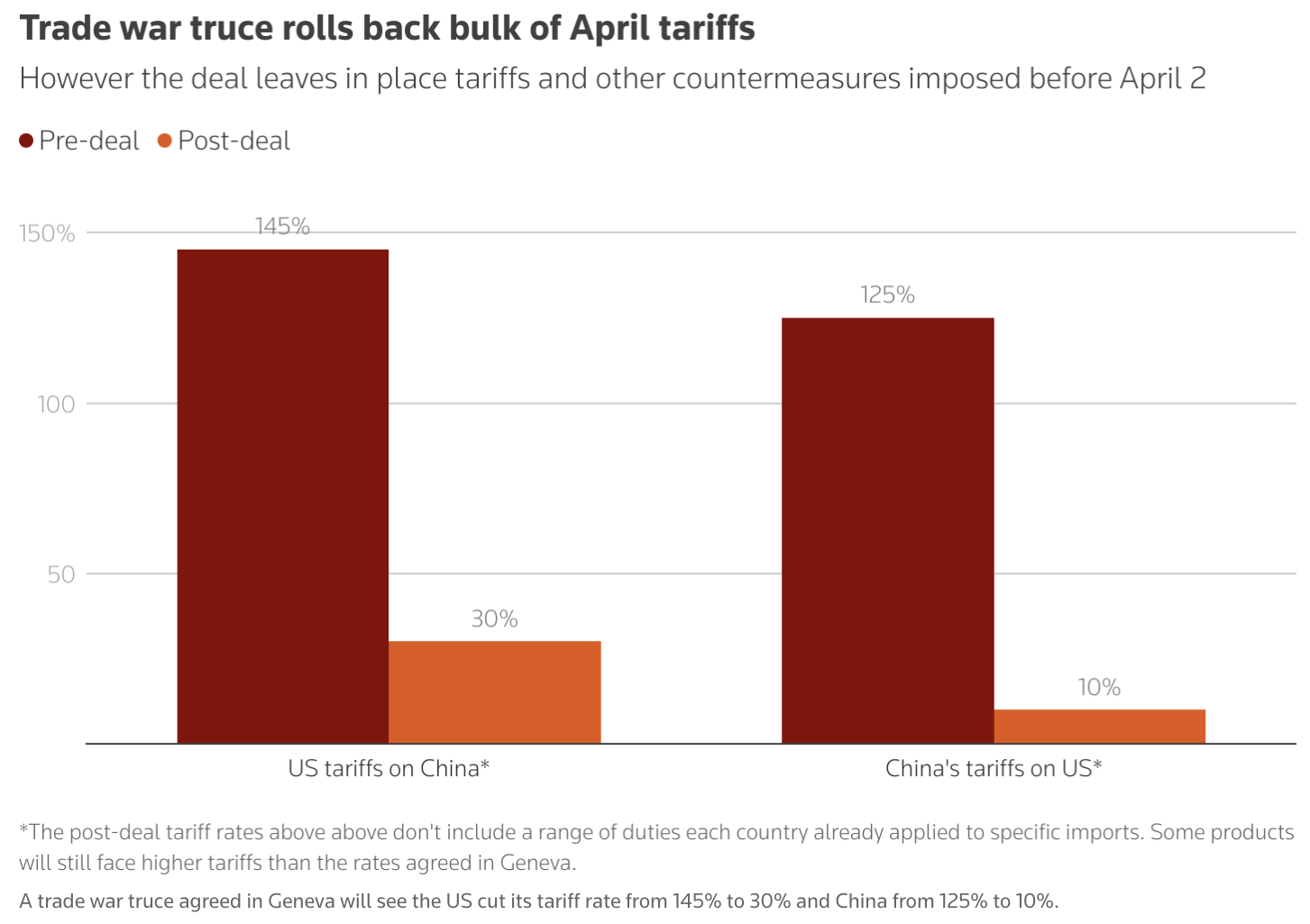The United States and China said they would temporarily cut tariffs for 90 days before May 14 while they continue negotiations. U.S. tariffs on Chinese goods will be 30 percent, instead of 145 percent, and China’s tariffs on American goods will be 10 percent, down from 125 percent. Sector-specific tariffs are not part of the deal. President Trump imposed targeted levies on items including Chinese-made semiconductors, medical devices, and aluminum and steel imports. China will also remove non-tariff export controls that it imposed on April 2, which could be a reference to China’s addition of seven rare earths to its export control list on April 4, though it was not explicitly stated.
The 30% U.S. duty is based on a combination of a 20% tariff imposed on China earlier in the year as a penalty for China’s role in the international trafficking of fentanyl and a 10% tariff generally placed on all U.S. trade partners. The 10% tariff is on par with the U.S. global baseline tariff on imports that remains in place as the Trump administration works to renegotiate trade agreements worldwide.
The agreement is expected to reduce inflationary pressures and benefit major retailers, even though low-cost e-commerce platforms like Shein and Temu, which were previously exempt under the “de minimis” policy, remain subject to a 120% tariff imposed earlier this month. According to Bloomberg, the new rates halve the stagflation hit to the U.S. economy, as the trade war had halted $600 billion in bilateral trade. The weekend resulted in the United States and China establishing an economic and trade consultation mechanism, allowing both sides to continue their negotiation.

While the joint statement from the meeting did not mention the de minimis duties, the White House later released an order that indicated the levies will be reduced to 54% from 120% for items valued at up to $800 sent from China via postal services, with a flat fee of $100 to remain, starting from May 14. Carriers can pay either the 54% or the $100 fee per package. The tariff fees are collected from sellers in China in advance. The de minimis exemption allowed items valued at up to $800 and sent from China via the postal service to previously enter the United States duty-free and with minimal inspections.
According to U.S. Treasury Secretary Scott Bessent, “What had occurred with these very high tariffs… was… the equivalent of an embargo, and neither side wants that. We do want trade, we want more balanced trade, and I think that both sides are committed to achieving that.” The United States has a larger goods trade deficit with China than with any other country, and President Trump has been unhappy with the fact that the United States buys substantially more goods from China than it sells to the country. Other concerns include a lack of protection for the intellectual property rights of American companies in China, including the forced transfer of technology. The Chinese government has also been accused of providing subsidies that give its companies an unfair advantage.
Future discussions may occur alternately in China and the United States, or a third country agreed upon by both countries. The two sides may also conduct working-level consultations on relevant economic and trade issues.
Impact on U.S. Imports of Reciprocal Tariffs
The impact of reciprocal tariffs was already being felt, with the number of shipping containers traveling to the United States from China falling dramatically since early April. Bookings are down anywhere from 30% to 50%. As a result of the tariffs, import cargo at the nation’s major container ports is expected to see its first year-over-year decline since 2023. Companies are sailing their vessels less because of paused manufacturing orders from shippers and fewer containers to fill, and ocean carriers are using smaller vessels to move trade.
MSC, the largest ocean carrier in the world, and the Gemini Alliance (comprised of Maersk and Hapag Lloyd) are two of the freight companies using smaller vessels. MSC has reduced its container capacity by 28%, and Ocean Alliance, a freight consortium that includes Chinese companies among others, has reduced container capacity by 26% year-over-year.
Nonetheless, the first Chinese goods subject to the 145% tariffs began arriving at the busiest ports in Los Angeles and Long Beach. Seven ships carrying about 12,000 shipping containers were on the first flotilla of freight vessels from China with goods for Amazon, Home Depot, Ikea, Ralph Lauren, Tractor Supply, Procter & Gamble, LG, and Samsung. Five more ships are on their way. In addition to housewares, apparel, and furniture, Amazon imported various products on behalf of sellers, including refrigerators, deep fryers, mousepads, bookshelves, and living room sofas. Tractor Supply orders include portable drum fans, garden tools, and men’s work boots, and Home Depot ordered lamps and ceiling fans.
Conclusion
While talks continue, the United States and China agreed to lower reciprocal tariffs for 90 days during their weekend negotiation in Switzerland. U.S. tariffs on Chinese goods will drop from 145% to 30%, and Chinese tariffs on U.S. goods will drop from 125% to 10%. Sector-specific tariffs, such as those on Chinese-made semiconductors, medical devices, and aluminum and steel imports, are not included. China agreed to remove non-tariff export controls, but whether that would include rare earth minerals on its export control list is unclear. The two countries now have a mechanism that will allow them to continue negotiations regarding leveling the playing field for tariffs, non-tariff trade barriers, intellectual property protections, and even the issue of fentanyl drug components, which have been a scourge in much of America. The high tariffs had already impacted trade as vessel bookings had dropped by 30% to 50%, and shipping companies were turning to smaller vessels.














